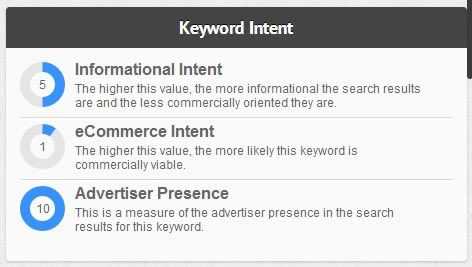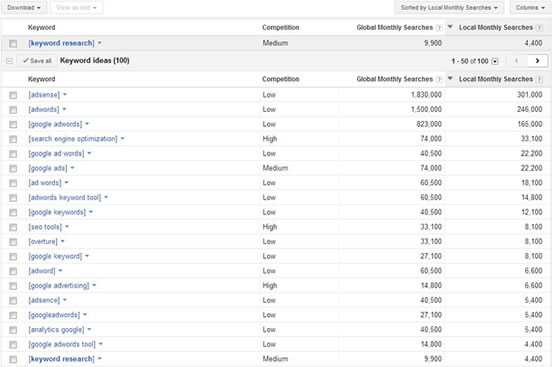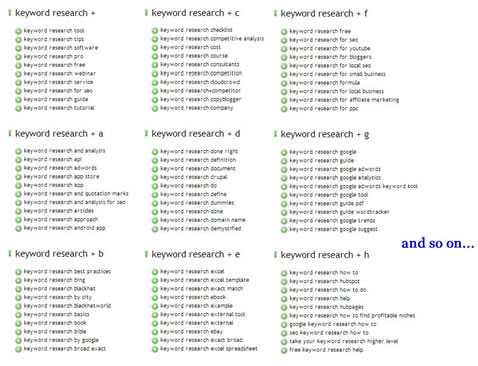关键词研究是要了解用户搜索信息时使用那些词语,通常包括了解关键词的搜索量,以及这些词的竞争情况
关键词研究是搜索引擎优化和搜索营销关键的一个环节。因为如果使用正确,他能够帮我们在开发网站和构建内容时提供路径。根据搜索查询的数量,关键词可以分类为头部,主体,长尾。一般而言,关键词的词越多,竞争相对没有那么激烈,也比较容易获得好的排名
说一般情况下是因为这个规律也非绝对,会有意外。下面是一些长尾关键词跟主体和头部关键词的难度指数对比。
这个案例是长尾关键词容易竞争点
这个例子则是长尾跟头部关键词同等难度
这个例子则是长尾关键词反而更难竞争
关键字难度数据是通过 SEOmoz’s keyword difficulty tool 获取,根据经验,一般包括有品牌的长尾关键词会比较难竞争,9/10的长尾关键词一般都要比主体和头部关键词容易
2 观点思考SEO一般可以分为两个目标:
获取流量
提高转化
很多SEO坏在过分强调获取流量,而不是转化。并不是说获取流量不对,这要结合你网站的目标。比如对于电子商务网站,获取有高转化价值的流量比单纯的流量更大。而如果是广告或媒体行业,眼球可能更加重要,这个时候获取流量就很正当。
因此我们需要思考:
更高的流量会直接带来更高的收入吗?
还是说你要确保获取那些转化指标较好的关键词带来的流量?
关键词的价值根据上面两点,关键词的价值可以基于下面两个维度:
跟竞争程度相关的月搜索量
收入潜力或转化率
找到相关的月搜索量可以使用Google’s keyword tool,但它并没有提供更多的信息。AdWords™提供了关键词的竞争程度,但你要需要知道这些已经在这些关键词搜索结果上获得排名的网站的权重。Mozbar extension for chrome, 这个工具可以给我一些详细的数据。但要做更复杂的分析,推荐使用SerpIQ,如下图所示
SEOmoz 有一个叫做keyword rank报告,如下图所示
但他并没有提供更详细的信息, SerpIQ 这个工具则提供了平均的竞争指数
以及搜索的意图
每个位置的搜索竞争指数
这些搜索结果网站的PageRank
外链数量
还有就是域名的年龄
研究搜索者的意图当要优化转化率时,了解目标受众的搜索意图是非常关键的。对关键词进行分类,根据不同的渠道和来源进行分析等都有助于我们了解用户的搜索意图。
开始研究了这里会用到很多工具,Google提供的Google’s keyword tool. 必然不可少。在利用这个工具的时候,记得选上精确匹配
下面是结果
给出了这些关键词的搜索量和竞争程度,然后导出,配合Übersuggest 可以获得更多的关键词搜索建议信息
如下图所示
This is really helpful because it captures all of the potential permutations related to your target keyword based onactual search behavior. You can now drill down into phrases and select the child keywords to be added to a list. Then click the ‘get’ button to generate a modal window that allows for you to copy and paste. Paste your selected related keyword back into the google keyword tool and rerun for more keyword data goodness. Tip: I’ve found that the Google keyword tool provides more suggested keywords when you put in less than 10 keywords at a time. Wordtracker also has a keyword suggestion tool although to really get any of the juice out of it you need to sign-up for a paid plan :/ There are also a variety of tools that provide keyword usage and competitiveness between both paid and organic search – some of which are pretty good. SEMrush - Gives you fantastic insight into search volume, average cost per click, number of competing pages, related keywords, rank results, and even companies currently buying ad space (click to enlarge).
SpyFu – Provides search volume, number of clicks per day and their average daily cost, the actual number of advertisers currently bidding on the keyword and the actual AdWord ads that are running (click to enlarge).
Keyword Spy - Is one of my favorites for getting a quick sense of the landscape. It very quickly (through use of tabs) gives you access to data on PPC ads, related keyword phrases, your paid and organic competitors, andmy favorite; misspellings! Did you know that keyword reserach has an estimated 110,000 searches per month! See a screenshot of the dashboard below (click to enlarge).
Validate The Big Opportunities
Once you have a good list going in Excel it’s important to gain visibility into your big opportunities, or as my team has come to talk call them; your golden tickets. First you will want to get a sense of seasonal volatility by running your top queries through Google Trends (click to enlarge):
Pay attention to the average index of interest over time, since it can be a bit confusing; 100 here represents the highest search volume there has ever been, it is not the integer for number of searches. So what you are looking for is that the current interest has not fallen off completely, looking at the graph it seems the current search volume for keyword research is down about 50% from what it was in August 2010. Next you use a bit of a 3rd party litmus test to see how popular a topic really is, and a safe bet here is to use the worlds most popular encyclopedia, Wikipedia. Domas Mituzas has built a statistical engine that tracks Wikipedia’s pageviews. And looking at it over the past 90 days we can see that the term has been viewed 7,554 times (hat tip to Glen Allsopp for sharing this). Click to enlarge.
Creating a Keyword Evaluation Model
Evaluating keywords for relative opportunities is still very tough. Without massive stores of data and detailed insights into the competitive landscape it is easy to throw a lot of time and money at targeting keywords that will never deliver a stable return. In order to avoid this and instead focus only where there is rank to be had and money to be made, I believe it’s best to use an evaluation method. There are a number of methodologies ranging from complex formulas including many different heuristics to more simplified models designed just to give you a sense of the opportunity. While I am working on a scaled-back version of my model to give away, it’s not quite ready yet – so for this post we are going to use a very simplified version. This is meant to be more of a barometer than anything else and this data should not be used to make a business case, but more so just to give you a sense of opportunity. I’m going to use keyword competitiveness scoring from SerpIQ, but you could also do this with SEOmoz’s keyword difficulty score or something similar. Scoring the opportunities takes some simple math. So for this version we are going to discount monthly search volume by multiplying is against the inverse discount rate of the competitive scores (1 minus the competitiveness index percentage). For this example I’m going to stick with our root phrase, keyword research, and use 2 other closely related variations:
Using our quick and dirty evaluation model of (exact monthly search volume x (1 – CI%) we get:keyword research opportunity score (4,400 x (1-.68)) = 1,408 keyword research tools opportunity score (720 x (1-.65)) = 252 keyword research software opportunity score (480 x (1-.56)) = 211.2 Showing (quickly remember) that even though keyword research is significantly harder in terms of competition, it is still the clear winner in terms of keywords to target for search traffic. This is useful because it takes it takes into account the opportunities as related to monthly search volume and then discounts the traffic potential based on the average competition.
Closing the Loop
Part of doing successful keyword research is setting time aside each month to analyze what’s working, and adjust your content and link strategies accordingly. Where are you seeing the fastest movement in the SERP’s? Are some terms moving between the top 10/30/50 positions faster than others? Which keywords are the fastest to page 1? Fastest to the top 5? Ask yourself these questions and please share your thoughts with me in the comments below – let me know your hypotheses or better yet your
actual data; share your research and tell me what worked and what didn’t, I would love to chat with you.
网站优化,SEO
更新日志
- 小骆驼-《草原狼2(蓝光CD)》[原抓WAV+CUE]
- 群星《欢迎来到我身边 电影原声专辑》[320K/MP3][105.02MB]
- 群星《欢迎来到我身边 电影原声专辑》[FLAC/分轨][480.9MB]
- 雷婷《梦里蓝天HQⅡ》 2023头版限量编号低速原抓[WAV+CUE][463M]
- 群星《2024好听新歌42》AI调整音效【WAV分轨】
- 王思雨-《思念陪着鸿雁飞》WAV
- 王思雨《喜马拉雅HQ》头版限量编号[WAV+CUE]
- 李健《无时无刻》[WAV+CUE][590M]
- 陈奕迅《酝酿》[WAV分轨][502M]
- 卓依婷《化蝶》2CD[WAV+CUE][1.1G]
- 群星《吉他王(黑胶CD)》[WAV+CUE]
- 齐秦《穿乐(穿越)》[WAV+CUE]
- 发烧珍品《数位CD音响测试-动向效果(九)》【WAV+CUE】
- 邝美云《邝美云精装歌集》[DSF][1.6G]
- 吕方《爱一回伤一回》[WAV+CUE][454M]























